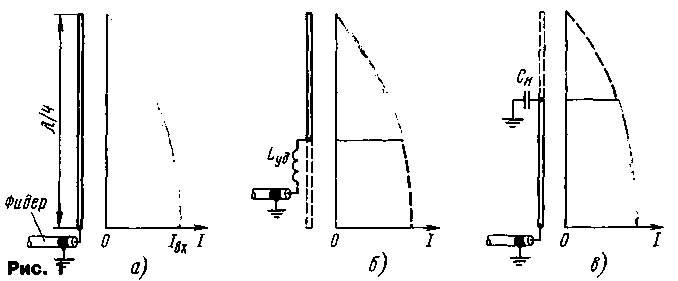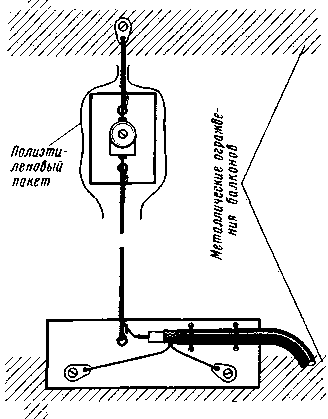Today, as at the dawn of Amateur radio, many hams have (for various reasons) to use the "balcony" of the antenna. Interesting decision "balcony GP" suggested by the author of this article.
As is known from antenna theory, in order to determine the intensity of an electromagnetic field generated by the transmitting antenna, it is necessary that the antenna be represented in the form of a plurality of segments - elementary radiators. At any point of the reception field intensity created by all of the antenna, is the sum of the field strengths generated by the radiation of each of these segments. In turn, the intensity of the field generated by elementary emitter is proportional to the current passing through it and its length.
To determine the current flowing through each elementary radiator, you must know the law of distribution of the current in the antenna, which depends on the antenna type. The law of distribution of current in the quarter-wave vibrator shown in Fig.1, and. He has cosinusoidally character.

Fig.1
A full-sized quarter-wave vertical vibrator for Amateur band 28 MHz or CB band 27 MHz on the balcony to install, naturally, not possible, not to mention the half-wave vibrator or popular vibrator length of 5/8l. So as balcony antennas are used shortened antenna.
In the industrial antennas antennas for mobile radio (and antenna length less than a quarter wavelength) to compensate for the capacitive component of the overall input resistance applied extension of the coil. The current distribution in a shortened vertical dipole with an extension coil shown in Fig.1,b. In relation to the quarter-wave vibrator in it as if excluded the lower part of the antenna, which is mounted coil inductance (extension coil) Lуд. As the current in the lower part of the quarter-wave vibrator to the maximum, by shortening the antenna in this way, we exclude the most effective part of it (the current distribution which is shown in Fig.1,b by a dotted line).
A question arises: is it possible to shorten the antenna to eliminate the lower part and the upper, in which the current minimum? Such a method exists, and antennas of this type are widespread, for example, as a transmission on the medium-wave radio stations. The antenna proposed in this article is the antenna of this type.
In order to understand the principle of operation and advantages of the proposed antenna, I would like to explain the principle of operation of such antennas in General. The upper part of the quarter-wave vibrator (Fig.1,a), can be represented as a separate vibrator, the length of which is less than a quarter wavelength. The input impedance of this vibrator has a capacitive character. Therefore, with some assumptions, the upper part of the quarter-wave vibrator can replace the load capacitor corresponding to capacitance CH. The antenna of this type, and also the current distribution it is shown in Fig.1,V. As can be seen from the figure, the current distribution in the antenna is more favorable compared to the current distribution in a shortened antenna with extension coil (Fig.1,b). In other words, in the same physical length of the antenna with extension coil and antenna with a capacitive load, the current length (height) is greater. The lack of extension of the coil in the antenna with a capacitive load, is also its advantage. Because the antennas, which uses an extension coil, a significant proportion of the loss falls on this coil.
In Fig. 2 shows easy to manufacture, but quite effective balcony antenna for Amateur band 28 MHz or CB range of 27 MHz. Feature of its design is that the antenna does not protrude beyond the edge of the balcony does not have an extension coil and balances are used the metal part of the balcony. The antenna may be formed on the balcony of a residential apartment in which as a basis the perimeter fence (parapet) is used, a metal structure (usually in the form of welded bars). The metal railing of the balcony of your apartment may well perform the function balances the antenna, and the metal fence upstream of the balcony - the role of "land" in the circuit of the capacitive load.

Fig.2
Braid of the coaxial cable connected to the metal parapet (the railing) balcony. The capacitor CH one output is connected to the top point of the leaf antenna, and the other output is the bottom metal parapet of the balcony of the upper floor. The capacitance of the capacitor CH is selected when the length of the vibrator (leaf antenna) - 1.6 m. This generally corresponds to the height of the ceilings of residential flats 2.5 m. If the length of the vibrator is different, then the capacity of the SN can be different. The greater the length of the vibrator, the less must be the capacity CH.
The antenna design shown in Fig. 3. The leaf antenna is made of an antenna cord (cross-section is not critical). You can use multiple twisted insulated wires. The ends of the wires must be stripped off the insulation and soldered together. The insulators on the ends of the sheet are in the form of plates of the PCB or other improvised insulating material. Trimmer capacitor CH - ceramic disc type KPC-1. The lower insulator of the antenna is attached to the fence with two bolts, which, moreover, through the terminals should provide a reliable electrical contact of the wire with metal railings. Also you need to drill a mounting hole in the bottom of the upstream parapet of the balcony. In this hole is also screwed a bolt that needs for reliable contact firmly clamping the terminal to which you should solder the wire connected to the rotor of trimmer capacitor CH.

Fig.3
The antenna tuning is performed using an SWR meter. Adjustment trimmer capacitor CH are making minimum SWR in the middle of the operating range.
Avoid exposure to rain on trimmer capacitor after setting the charge on the capacitor should wear a plastic bag, then tightly fasten to the wire coming from this Board to the upper balcony. The bottom edge of the package should be free - it will prevent the formation of condensation inside the package and not allowed to accumulate moisture there.
It should be noted that the proposed antenna is not suitable for use with the amplifier. First, in this antenna, as in the quarter-wave vibrator, the voltage at the upper end of the vibrator is several times higher than the voltage applied to the antenna feeder (at the bottom of the vibrator). Therefore, if the input power exceeds approximately 20 W, trimmer capacitor CH can be broken and when moisture breakdown may occur at reduced power. Secondly, when a large input power on the metal railings of the balconies can be quite large RF voltage. (At power up to 20 watts, this stress can't cause any trouble). However, the use of other balcony antennas to work with large capacity is not recommended for health and hygiene reasons.
Without any changes in the design (only required tuning capacitor) antenna works pretty well in the range of 27 MHz (CB). In my opinion, shortened antenna with capacitive load is just perfect for balcony living apartment. Especially good results when working on balcony antenna work if the radio station is located on the upper floors of a multistory building, and if the direction of the correspondent lies within the semicircle bounded by the wall of the house from the balcony (±90° from the direction perpendicular to the wall).
Literature
Publication: N. Bolshakov, rf.atnn.ru






